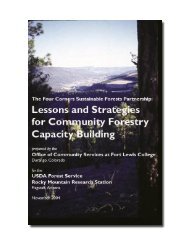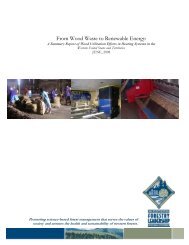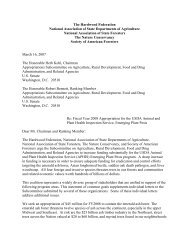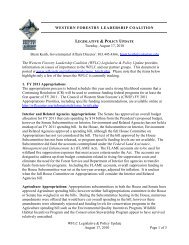Emission Controls for Small Wood-Fired Boilers - Western Forestry ...
Emission Controls for Small Wood-Fired Boilers - Western Forestry ...
Emission Controls for Small Wood-Fired Boilers - Western Forestry ...
Create successful ePaper yourself
Turn your PDF publications into a flip-book with our unique Google optimized e-Paper software.
9.0 OVERVIEW OF EMISSION CONTROLS FOR OTHER RELEVANT<br />
POLLUTANTS<br />
9.1 Nitrogen Oxides (NOx)<br />
There are two major sources of NOx emissions. The first, “fuel NOx” is NOx produced by the oxidation of<br />
fuel bound nitrogen during combustion. The second, “thermal NOx” is NOx produced by the oxidation of<br />
nitrogen in the combustion air. The latter is produced at temperatures typically much higher than those<br />
occurring during biomass combustion. There<strong>for</strong>e, the total NOx is most influenced by the fuel nitrogen<br />
content.<br />
Combustion controls are the only way NOx emissions are controlled apart from add‐on controls such as<br />
selective catalytic reduction (SCR) or selective noncatalytic reduction (SNCR).<br />
Increasing excess air can help control thermal NOx emissions by reducing flame temperature. Oxygen<br />
concentration is an indicator of the amount of excess air; there<strong>for</strong>e, monitoring oxygen concentration and<br />
linking oxygen measurements with automated controls establish the appropriate quantity of excess air<br />
on a continual basis and prevent excess thermal NOx emissions.<br />
Staged combustion is another means <strong>for</strong> controlling thermal NOx emissions.<br />
9.2 Sulfur Dioxide (SO 2 )<br />
SO 2 emissions from wood combustion are negligible given very low sulfur content in biomass.<br />
9.3 Carbon Monoxide (CO)<br />
Carbon monoxide emissions are minimized by good combustion conditions, specifically, maintaining the<br />
proper air to fuel ratio. Plume opacity observation, proper operation and maintenance, periodic<br />
combustion efficiency testing, and in‐situ oxygen concentration monitoring are ways to ensure ongoing<br />
good combustion conditions. A combustion chamber designed with staged combustion increases the<br />
degree of combustion completeness and is there<strong>for</strong>e useful <strong>for</strong> minimizing CO emissions.<br />
9.4 Volatile Organic Compounds (VOCs)<br />
The same measures <strong>for</strong> minimizing CO emissions will minimize VOC emissions.<br />
9.5 Hazardous Air Pollutants (HAPs)<br />
Hazardous air pollutants include both gaseous and particulate based pollutants. The a<strong>for</strong>ementioned<br />
controls <strong>for</strong> CO and are also effective at controlling HAPs, but most effective at controlling gaseous HAPs.<br />
Particulate HAPs are also controlled with an add‐on control device.<br />
Resource Systems Group, Inc.<br />
<strong>Emission</strong> Control Technologies <strong>for</strong> <strong>Small</strong> <strong>Wood</strong>‐<strong>Fired</strong> <strong>Boilers</strong><br />
6 May 2010 Page 24










